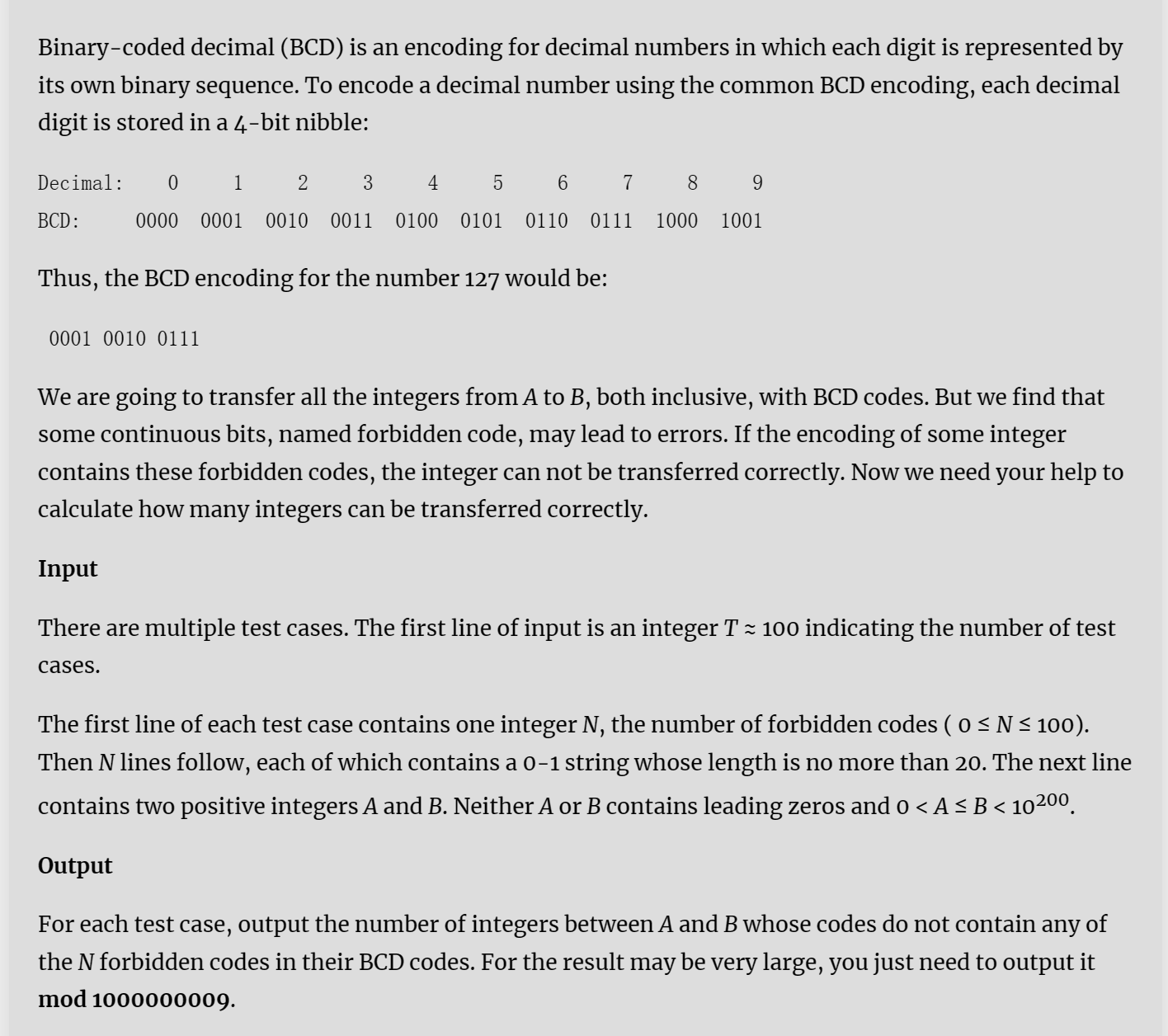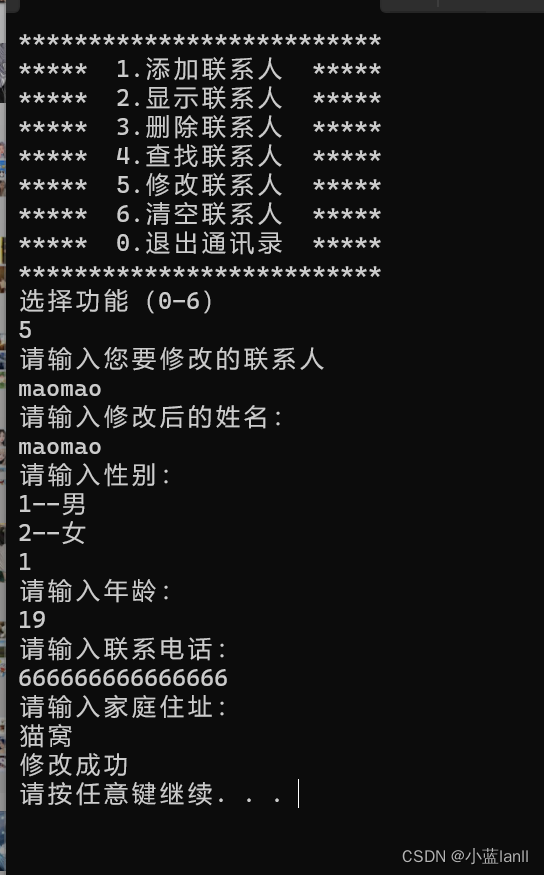BCD Code

题意
将十进制数的每一位数位转化成一个 4 4 4 位的二进制数,并给定一些 禁止码,规定符合条件的数字的二进制表示中不能包含连续的某个禁止码。问 [ l , r ] [l,r] [l,r] 中有多少个符合条件的数字
思路
朴素的数位 D P DP DP 只涉及少量的禁止码,而这道题涉及的禁止码多达 100 100 100 个,所以要用 A C AC AC 自动机 来完成多模匹配。我们可以用当前匹配的状态在 A C AC AC 自动机的 T r i e Trie Trie 上的节点编号来表示当前的限制。
d p [ p o s ] [ n o w ] dp[pos][now] dp[pos][now] 表示 p o s pos pos 个全变化位,当前搜到了 T r i e Trie Trie 上的 n o w now now 号节点所包含的符合条件的数量。当我们枚举当前位为 0 0 0 ~ 9 9 9 时,我们要从 n o w now now 往下走 4 4 4 步,这每一步都不能走到某个禁止码的末尾,它的某个 f a i l fail fail 指针指向的点也不能是某个禁止码的末尾。由于 T r i e Trie Trie 建好后就固定了,所以我们可以预处理树上每个点往下走的路径是 0 0 0 ~ 9 9 9 的 10 10 10 种情况的节点编号,如果路上遇到了某个禁止码,那么就移到 − 1 -1 −1 节点。
在记忆化搜索的过程中注意一下前导 0 0 0 就可以了。代码中的 Z Z Z 类型是我借鉴 j i a n g l y jiangly jiangly 的大数取模类型,可以当成一个会自动取模的 l o n g l o n g long long longlong 就可以
#include<bits/stdc++.h>
#define fore(i,l,r) for(int i=(int)(l);i<(int)(r);++i)
#define fi first
#define se second
#define endl '\n'
#define ull unsigned long long
#define ALL(v) v.begin(), v.end()
#define Debug(x, ed) std::cerr << #x << " = " << x << ed;
const int INF=0x3f3f3f3e;
const long long INFLL=1e18;
typedef long long ll;
template<class T>
constexpr T power(T a, ll b){
T res = 1;
while(b){
if(b&1) res = res * a;
a = a * a;
b >>= 1;
}
return res;
}
constexpr ll mul(ll a,ll b,ll mod){ //快速乘,避免两个long long相乘取模溢出
ll res = a * b - ll(1.L * a * b / mod) * mod;
res %= mod;
if(res < 0) res += mod; //误差
return res;
}
template<ll P>
struct MLL{
ll x;
constexpr MLL() = default;
constexpr MLL(ll x) : x(norm(x % getMod())) {}
static ll Mod;
constexpr static ll getMod(){
if(P > 0) return P;
return Mod;
}
constexpr static void setMod(int _Mod){
Mod = _Mod;
}
constexpr ll norm(ll x) const{
if(x < 0){
x += getMod();
}
if(x >= getMod()){
x -= getMod();
}
return x;
}
constexpr ll val() const{
return x;
}
explicit constexpr operator ll() const{
return x; //将结构体显示转换为ll类型: ll res = static_cast<ll>(OBJ)
}
constexpr MLL operator -() const{ //负号,等价于加上Mod
MLL res;
res.x = norm(getMod() - x);
return res;
}
constexpr MLL inv() const{
assert(x != 0);
return power(*this, getMod() - 2); //用费马小定理求逆
}
constexpr MLL& operator *= (MLL rhs) & { //& 表示“this”指针不能指向一个临时对象或const对象
x = mul(x, rhs.x, getMod()); //该函数只能被一个左值调用
return *this;
}
constexpr MLL& operator += (MLL rhs) & {
x = norm(x + rhs.x);
return *this;
}
constexpr MLL& operator -= (MLL rhs) & {
x = norm(x - rhs.x);
return *this;
}
constexpr MLL& operator /= (MLL rhs) & {
return *this *= rhs.inv();
}
friend constexpr MLL operator * (MLL lhs, MLL rhs){
MLL res = lhs;
res *= rhs;
return res;
}
friend constexpr MLL operator + (MLL lhs, MLL rhs){
MLL res = lhs;
res += rhs;
return res;
}
friend constexpr MLL operator - (MLL lhs, MLL rhs){
MLL res = lhs;
res -= rhs;
return res;
}
friend constexpr MLL operator / (MLL lhs, MLL rhs){
MLL res = lhs;
res /= rhs;
return res;
}
friend constexpr std::istream& operator >> (std::istream& is, MLL& a){
ll v;
is >> v;
a = MLL(v);
return is;
}
friend constexpr std::ostream& operator << (std::ostream& os, MLL& a){
return os << a.val();
}
friend constexpr bool operator == (MLL lhs, MLL rhs){
return lhs.val() == rhs.val();
}
friend constexpr bool operator != (MLL lhs, MLL rhs){
return lhs.val() != rhs.val();
}
};
const ll mod = 1000000009;
using Z = MLL<mod>;
char code[220]; //错误码
int cnt; //AC自动机节点数量
struct node{
int son[2];
bool end; //code结尾标记
int fail;
}tree[2500];
int nxt[2500][10]; //Trie上的点往后移动后的节点编号
Z dp[220][2500];
int num[220];
void insert(char* s){
int now = 0;
int n = strlen(s);
fore(i, 0, n){
int ch = s[i] - '0';
if(!tree[now].son[ch])
tree[now].son[ch] = ++cnt;
now = tree[now].son[ch];
}
tree[now].end = true;
}
void getFail(){
std::queue<int> q;
fore(i, 0, 2)
if(tree[0].son[i])
q.push(tree[0].son[i]);
while(!q.empty()){
int now = q.front();
q.pop();
tree[now].end |= tree[tree[now].fail].end; //code结尾标记向下传递
fore(i, 0, 2){
if(tree[now].son[i]){
tree[tree[now].son[i]].fail = tree[tree[now].fail].son[i];
q.push(tree[now].son[i]);
}
else tree[now].son[i] = tree[tree[now].fail].son[i];
}
}
}
int judge(int now, int d){ //d是十进制数,将其转成二进制后在Trie上移动
for(int i = 3; i >= 0; --i){
int ch = ((d >> i) & 1);
if(tree[tree[now].son[ch]].end) return -1; //下一个位置是一个禁止码
now = tree[now].son[ch]; //往下走
}
return now;
}
Z dfs(int pos, int now, bool lead, bool limit){
if(!pos) return 1;
if(!lead && !limit && dp[pos][now].x != -1) return dp[pos][now];
Z res = 0;
int up = (limit ? num[pos] : 9);
fore(i, 0, up + 1){
if(lead && !i) res += dfs(pos - 1, now, true, limit && i == up);
else if(nxt[now][i] != -1) res += dfs(pos - 1, nxt[now][i], false, limit && i == up);
}
if(!lead && !limit) dp[pos][now] = res;
return res;
}
Z solve(std::string& s){
int len = 0;
for(auto it = s.rbegin(); it != s.rend(); ++it){
num[++len] = *it - '0';
}
return dfs(len, 0, true, true);
}
int main(){
std::ios::sync_with_stdio(false);
std::cin.tie(nullptr);
std::cout.tie(nullptr);
int t;
std::cin >> t;
while(t--){
fore(i, 0, 220)
fore(j, 0, 2200)
dp[i][j].x = -1;
int n;
std::cin >> n;
while(n--){
std::cin >> code; //读入错误码
insert(code);
}
getFail();
/* 预处理Trie上每个节点往后走的情况的节点编号,以及是否会走到某个code */
fore(i, 0, cnt + 1)
fore(j, 0, 10)
nxt[i][j] = judge(i, j);
std::string l, r;
std::cin >> l >> r;
/* l - 1 */
for(int i = l.size() - 1; i >= 0; --i)
if(l[i] == '0')
l[i] = '9';
else{
--l[i];
break;
}
Z ans = solve(r) - solve(l);
std::cout << ans << endl;
/* 重置 Trie */
fore(i, 0, cnt + 1){
tree[i].fail = tree[i].end = 0;
fore(j, 0, 2) tree[i].son[j] = 0;
}
cnt = 0;
}
return 0;
}


















